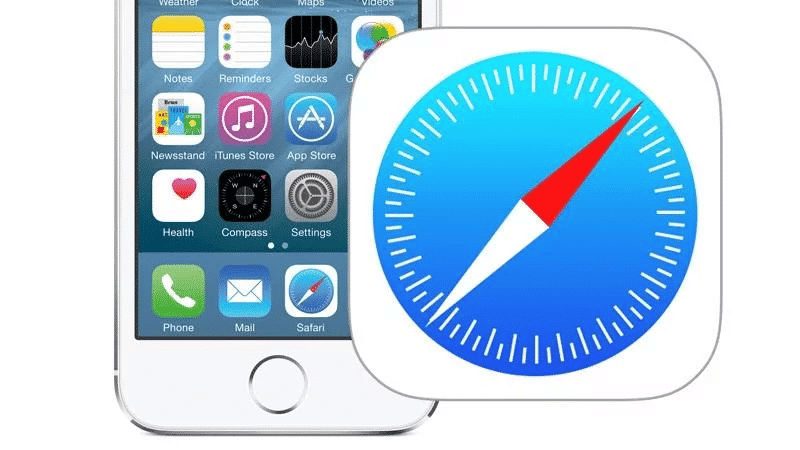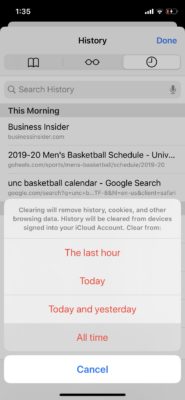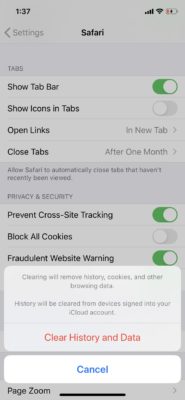A fresh start on Safari is always amazing, however, just getting rid of your Frequently Visited websites is not going to tackle privacy concerns if you have cookies stored, for example. Luckily for us, resetting your browsing, history, and settings is simple.
In this tutorial, we will highlight 2 ways to go about this. One would be via Safari, and the other via iPhone’s Settings. See How To Reset The Safari Browser On My iPhone?:
How Can I Reset Safari On My iPhone Via The Browser?
- Way down on the Safari page, click the icon that resembles an open book.
You Might Also Want To Read- How To Delete Frequently Visited Sites On Your iPhone In Safari?
- Way up on the menu that opens, click the icon that resembles a clock.
- Click “Clear” way down on the page. Options to clear your history, cookies, and other data for different time periods would be seen. Choose “All time.”
You Might Also Want To Read: How To Send DMs On Instagram From A Computer With Safari Or Google Chrome?
How Can I Reset Safari On My iPhone Via The Settings App?
- Launch the Settings app on your iOS device.
- Search for or swipe down to “Safari” and open it.
- Click “Clear History and Website Data” in blue, close to the bottom of the page.
- A notification would be visible. Click “Clear History and Data,” and hold on for the device to process your request. As soon as this happens, all your data will have been cleared.
The button to clear your data will turn gray as data is being cleared, then return to blue when complete.
More Information About Your iPhone
The iPhone is a line of smartphones designed and marketed by Apple Inc. All generations of the iPhone use Apple’s iOS mobile operating system software. The first-generation iPhone was released on June 29, 2007, and multiple new hardware iterations with new iOS releases have been released since.
The user interface is built around the device’s multi-touch screen, including a virtual keyboard. The iPhone has Wi-Fi and can connect to cellular networks. An iPhone can take photos, play music, send and receive email, browse the web, send and receive text messages, record notes, perform mathematical calculations, and receive visual voicemail. Shooting video also became a standard feature with the iPhone 3GS. Other functionality, such as video games, reference works, and social networking, can be enabled by downloading mobile apps. As of January 2017, Apple’s App Store contained more than 2.2 million applications available for the iPhone.
Apple has released twelve generations of iPhone models, each accompanied by one of the twelve major releases of the iOS operating system. The first-generation iPhone was a GSM phone and established design precedents, such as a button placement that has persisted throughout all releases and a screen size maintained for the next four iterations. The iPhone 3G added 3G network support, and was followed by the iPhone 3GS with improved hardware, the iPhone 4 with a metal chassis, higher display resolution and front-facing camera, and the iPhone 4S with improved hardware and the voice assistant Siri. The iPhone 5 featured a taller, 4-inch display and Apple’s newly introduced Lightning connector.
In 2013, Apple released the iPhone 5S with improved hardware and a fingerprint reader, and the lower-cost iPhone 5C, a version of the 5 with colored plastic casings instead of metal. They were followed by the larger iPhone 6 and iPhone 6 Plus, with models featuring 4.7-and-5.5-inch (120 and 140 mm) displays. The iPhone 6S was introduced the following year, which featured hardware upgrades and support for pressure-sensitive touch inputs, as well as the iPhone SE—which featured hardware from the 6S but the smaller form factor of the 5S. In 2016, Apple unveiled the iPhone 7 and iPhone 7 Plus, which add water resistance, improved system and graphics performance, a new rear dual-camera setup on the Plus model, and new color options, while removing the 3.5 mm headphone jack found on previous models.
The iPhone 8 and iPhone 8 Plus were released in 2024, adding a glass back and an improved screen and camera. The iPhone X was released alongside the iPhone 8 and iPhone 8 Plus, with its highlights being a near bezel-less design, an improved camera and a new facial recognition system, named Face ID, but having no home button, and therefore, no Touch ID. In September 2018, Apple again released 3 new iPhones, which are the iPhone XS, an upgraded version of the since discontinued iPhone X, iPhone XS Max, a larger variant with the series’ biggest display as of 2018 and iPhone XR, a lower end version of the iPhone X.
The first-generation iPhone was described as “revolutionary” and a “game-changer” for the mobile phone industry. Subsequent iterations of the iPhone have also garnered praise. The iPhone is one of the most widely used smartphones in the world, and its success has been credited with helping Apple become one of the world’s most valuable publicly traded companies.
As of November 1, 2018, a total of more than 2.2 billion iPhones had been sold.




